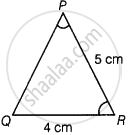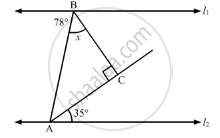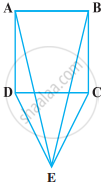Advertisements
Advertisements
प्रश्न
In ∆PQR, ∠R = ∠P and QR = 4 cm and PR = 5 cm. Then the length of PQ is ______.
पर्याय
4 cm
5 cm
2 cm
2.5 cm
उत्तर
In ∆PQR, ∠R = ∠P and QR = 4 cm and PR = 5 cm. Then the length of PQ is 4 cm.
Explanation:
Given, ∆PQR such that ∠R = ∠P, QR = 4 cm and PR = 5 cm
In ∆PQR, ∠R = ∠P
⇒ PQ = QR ...[Sides opposite to equal angles are equal]
⇒ PQ = 4 cm ...[∵ QR = 4 cm]
Hence, the length of PQ is 4 cm.
APPEARS IN
संबंधित प्रश्न
Find the measure of each exterior angle of an equilateral triangle.
If the base of an isosceles triangle is produced on both sides, prove that the exterior angles so formed are equal to each other.
P is a point on the bisector of an angle ∠ABC. If the line through P parallel to AB meets BC at Q, prove that triangle BPQ is isosceles.
Fill the blank in the following so that the following statement is true.
In an isosceles triangle ABC with AB = AC, if BD and CE are its altitudes, then BD is …… CE.
Which of the following statements are true (T) and which are false (F)?
Sum of any two sides of a triangle is greater than twice the median drawn to the third side.
Fill in the blank to make the following statement true.
If two sides of a triangle are unequal, then the larger side has .... angle opposite to it.
In the given figure, for which value of x is l1 || l2?

In the given figure, what is y in terms of x?

The side BC of ΔABC is produced to a point D. The bisector of ∠A meets side BC in L. If ∠ABC = 30° and ∠ACD = 115°, then ∠ALC = ______.
CDE is an equilateral triangle formed on a side CD of a square ABCD (Figure). Show that ∆ADE ≅ ∆BCE.

